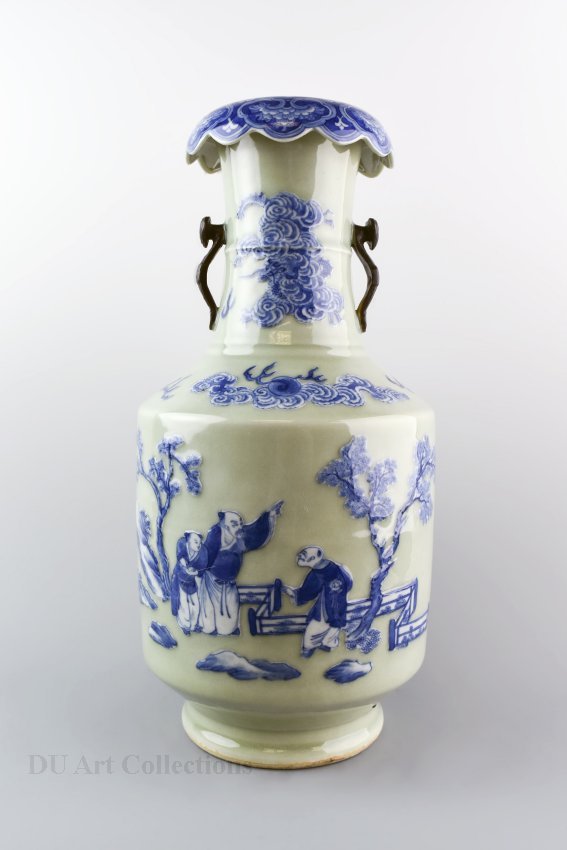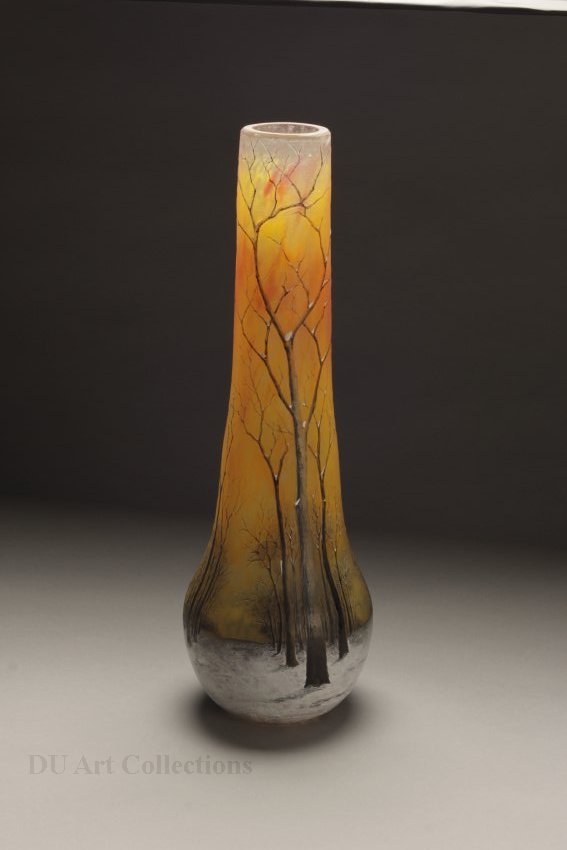Collection Spotlights
Collection Spotlights
The University of Denver Art Collections has over 8,000 objects. Collection Spotlights are one of the many ways students engage with art in our collection. Often focusing on recent acquisitions, objects on display across campus, or something interesting they found when exploring the Hampden Center, undergraduate and graduate students have the opportunity to write anything about any object in the collection. Emphasizing creative inquiry, the Collection Spotlights deepen our understanding of the objects in our collection and allow the versatility of the UAC to shine!
Celadon and Blue Glaze Porcelain Vase

The history of Chinese blue and white porcelain begins in the Tang Dynasty, 618-907 CE. Trade along the Silk Road introduced cobalt from Persia to the porcelain process, and by the 16th century, the vibrant hand-painted porcelain we know today was one the China’s most demanded exports. Chinese blue and white porcelain influenced ceramic traditions across Asia and Europe and became a symbol of China’s enduring cultural heritage. The pieces in the University of Denver Art Collections display some of the notable characteristics, such as dynamic and adaptable floral and animal motifs, landscapes, figural scenes, and intricate designs, which earned blue and white porcelain international acclaim.
During the Eastern Han dynasty, 25-200 CE, celadon glaze was created to mimic jade’s light green hue. Its signature color comes from the iron-rich slip applied to the ceramic before firing. Looking closely at this vase, you can see a thin border between the painted design and the celadon glaze. This is caused by using wax to protect the painted design from the glaze. The wax evaporates during the firing process, allowing the blue design to stand out against the vase’s green surface.
This piece is currently on view in the lobby of Sturm Hall in a small show of Blue and White Chinese Porcelain from the University Art Collections, curated by Chloe LeRoy, Graduate Class of 2025.
Daum Frères, Winter Scene, c. 1900. Acid-etched enameled glass

Art Nouveau (or “new art”) was an international style known by many names: Style Jules Verne, Le Style Métro, Art Belle Époque, and Art fin de siècle in France, Jugendstil in Germany, Stile Floreale in Italy, and Modernismo in Spain.1 This “new style” was developed in the late 1880s as a reaction against the historical revivals, which looked to the past for artistic and architectural design. In search of something new, Art Nouveau artists turned to the natural world, rejecting the order, symmetry, linearity, and regularity of the past, and finding inspiration in the organic, flowing, sinuous lines of flora. Art Nouveau flourished in the decorative arts, like furniture and glassware. Art Nouveau adherents wanted to create greater equity between the “high arts”–like painting and sculpture–and craft, resisting the stratification of the arts and limitations of traditions and expectations. As fast as it arrived, Art Nouveau was considered old-fashioned and largely abandoned for Art Deco style by about 1910-1920. This work demonstrates the free-flowing, asymmetric compositions that characterized Art Nouveau works, and they stand out in contrast to the rigid, orderly, balanced, geometric designs of earlier eras.
The Daum Brothers, Auguste (1853-1909) and Antonin (1854-1930), were the sons of a French glassmaker. Their company, Daum Frères, went on to revolutionize the glass-making world. The brothers were fascinated by the works of Emile Gallé. Elder brother Auguste oversaw the finance and administration of their company, giving Antonin artistic freedom. Their glassware is full of colorful natural imagery, with flowing, asymmetrical lines. Their works displayed here show naturalistic landscapes, with the forms of the trees echoing the elongated shape of the vessels. The Daum winter scene with several snow-covered birch trees set against a dark yellow background is probably the most recognizable pattern Daum produced. The later works from between 1910 and 1920 are more abstracted, organic forms, with a dark red color that is dramatic, moody, and intense. By the 1920s, Daum glassworks had shifted towards an Art Deco style, which was influenced by bold, geometric forms and bright colors.
By Lauren Anuszewski, Graduate Class of 2023
Helen B. Davis, Untitled, Acrylic on shaped canvas.

Helen Davis’s life was dedicated to people and art. Her adventurous approach to art was nurtured at Northwest Missouri State University, experimenting across a wide variety of media. Davis moved to Colorado in 1948 and established an arts therapy program at Fitzsimmons Army Hospital.
Davis has long been affiliated with the University of Denver. She received her Ed.D. from DU in 1961. Her experience of gender-based discrimination reinforced Davis’s feminist convictions and inspired her lifelong mentorship of and advocacy for women. She went on to lead the art department at Colorado Women’s College from 1962 to 1971. Later, Davis led the Boulder Valley School District’s art program and helped develop the Boulder Arts Commission. For her pioneering contributions, the University of Denver awarded Davis the Professional Achievement Award in 2009.
The Davis Gallery, named in her honor, opened in January 2022 and has featured dozens of creative and engaging exhibitions, largely emphasizing the innovative work of students in the School of Art and Art History. The University of Denver is immensely grateful for Davis’s generous support and leadership.
This work was featured in the Davis Gallery exhibition “Recent Acquisitions: Artworks by Former DU Faculty,” which ran from September 12 to October 11, 2024.
By Annie Drysdale, Graduate Class of 2025
Venus de Milo, Plaster Cast.

The only surviving gift of roughly 200 plaster casts gifted to the University of Denver in the 1890s, the Venus de Milo cast was one of the earliest objects given to the collection. It is a high-quality cast, taken from molds that preserved much of the stone texture of the original marble, including chips and losses. In the earliest days of formal art education in Colorado, the accepted measure of art education remained “classical” training—that is to say, training in the academic European tradition. The emphasis on drawing from antique sculpture was the core of most programs. Since the group of accepted antique and Renaissance models was limited to a number of precious and unattainable originals, the plaster cast itself came to take on a unique significance in art education. While teaching from antique and Renaissance casts fell out of fashion in the early 20th century, drawing from such works has not entirely disappeared from the art curriculum. Even today, basic drawing instruction at DU includes assignments to draw the surviving cast of the Venus de Milo.
In 2009, SAAH pre-conservation students were supervised by a professional art conservator as they removed layers of dirt, grime, and water-based paints from the cast’s surface. Since this conservation project was completed, the Venus de Milo cast has been on display in the Shwayder Art Building Lobby.
Hung Liu, Mountain Ghost, 2012. Oil paint on canvas.
This painting is an interpretation of the poem Mountain Ghost or Mountain Spirit by the Chinese poet Qu Yuan (338-278 BC) about a Mountain Spirit who is longing for her lover. In the aftermath of the Cultural Revolution at the end of the 1970s, Qu Yuan became a symbol of intellectual freedom and individual integrity. By integrating traditional-style painting into this piece, Hung Liu creates an impactful fusion of symbols, tradition, and her contemporary perspective on his poem.

Mountain Spirit by Qu Yuan
There seems to be someone in the mountain hollow
Draped in creeping fig with pine-gauze sash,
Peering through narrowed eyes, and sweetly smiling too.
“You desire me, for you love my lithe beauty.”
Drawn by red panthers, followed by striped wild cats,
Her magnolia wagon flies a flag of woven cinnamon bark.
Cloaked in orchids, asarum sash around her waist,
She picks the sweetest flowers and herbs to give to her love.
“I live deep in a bamboo grove and never see the sky.
The road was hard and dangerous – I was the late one.
“I stand on the mountain exposed and alone,
The clouds are a land of shifting shapes beneath my feet.
Vast is the darkness, yes, daylight benighted –
A breeze from the east, the spirits bring rain.
Stay with me, Spirit Adorned, and find such ease you’ll forget your home.
Once I am late in years, who will make me flower again?
“I pick the spirit mushrooms in the mountains
Amid rock piles and spreading kudzu.
I am angry, Lord’s son, so hurt I forget I have a home.
You long for me, but find no time.
“We in the mountains love the fragrance of galangal,
We find drink in the stone springs and shade beneath cypress and pine.
Afraid to act you long for me.
“Thunder rolls through rain’s dark veils,
Hear the grey gibbon week and the black gibbon’s night cry
Against the soughing wind and the whistling trees.
Longing for you, Lord’s son, I suffer in vain.”
Translated by Gopal Sukhu and the Asian Classics Editorial Board in Songs of Chu: An Anthology of Ancient Chinese Poetry by Qu Yuan and Others (2017).
